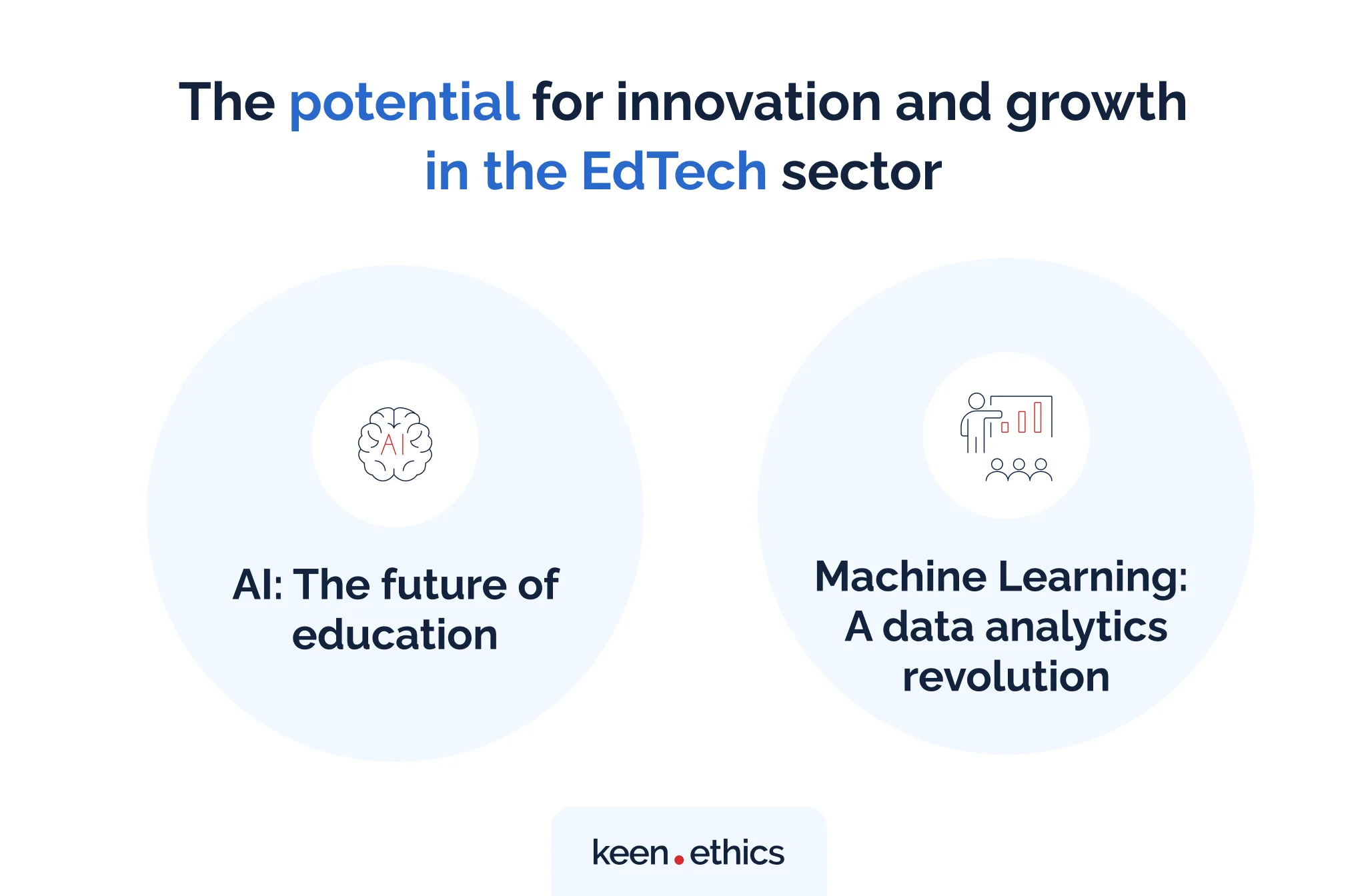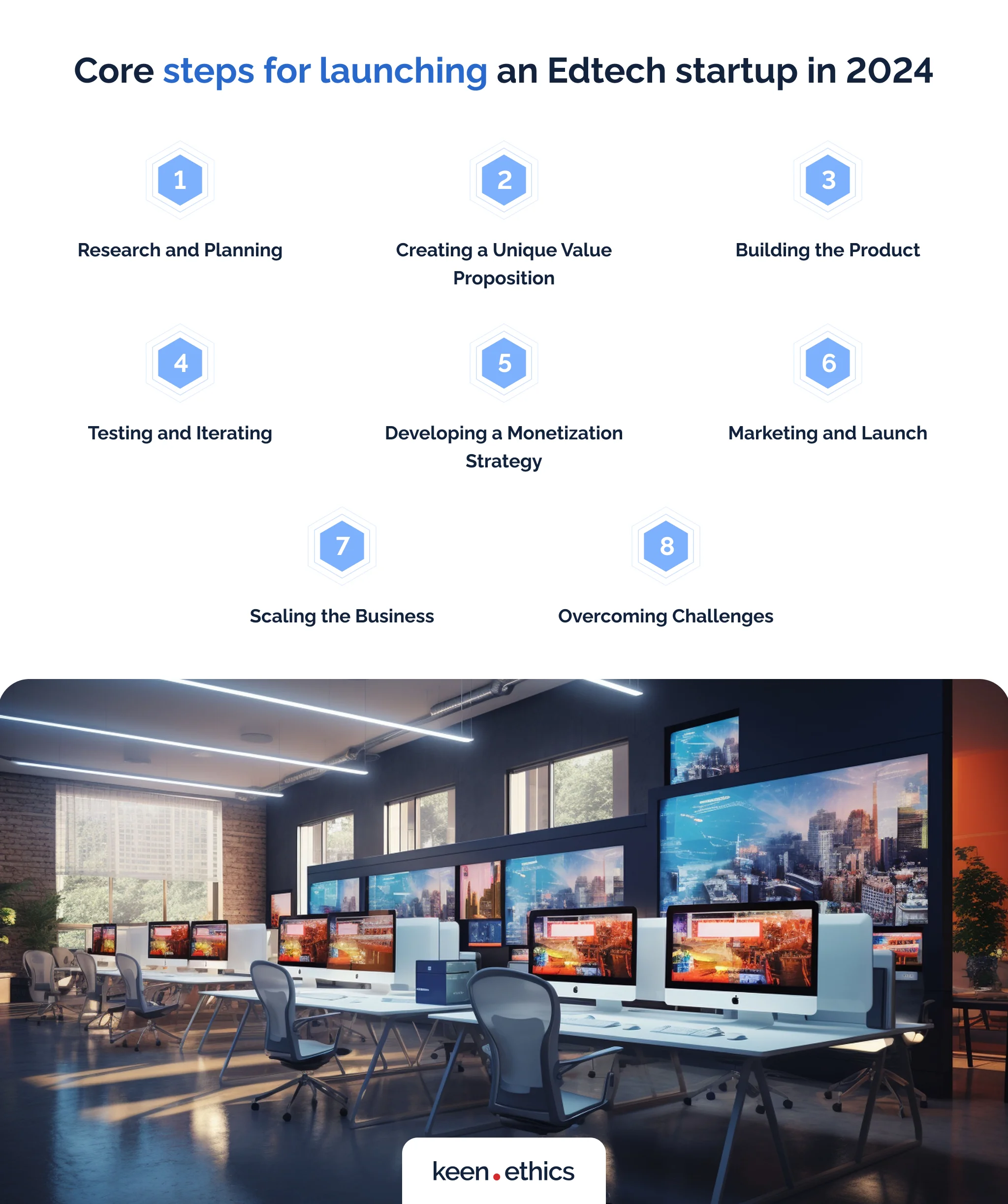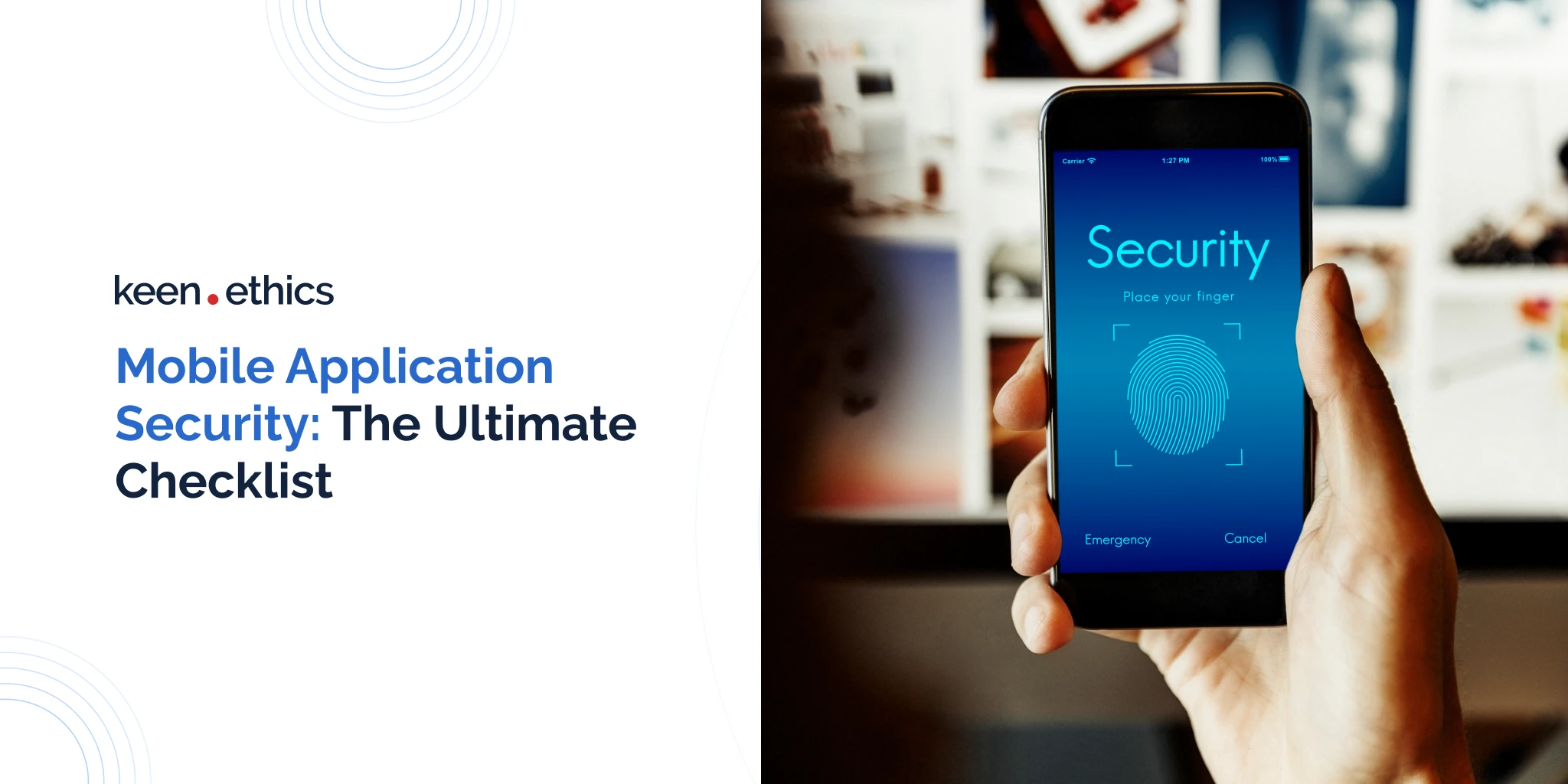Starting an edtech company may be one of the most rational decisions for modern investors in the education industry. The edtech industry is among the most promising digital markets in the modern world. Why? Education is a product that isn’t going to ever lose demand. Our society constantly creates a target customer for this sector. After all, there’s no such thing as too much education.
Every piece of knowledge you have makes you stronger and more employable in the labor market. Edtech also makes education more accessible in regions without good opportunities in the education field. Everyone can download an app as long as Internet access is available. Consequently, it’s not surprising that the projections for the edtech target market are so positive. According to the existing statistics, the edtech market will grow from approximately 146 billion US dollars in 2023 to 549 billion in 2033. In this article, our goal is to review the presented market and offer a set of recommendations on entering it.
Importance of EdTech in Modern Education

Edtech is undoubtedly one of the most important fields for modern education. Firstly, edtech technologies, as mentioned previously, greatly enhance accessibility compared to traditional education. People in countries with lower education opportunities can use edtech apps to get a high-quality education. A good example of this approach is the presence of many Harvard courses online. Platforms like edX promote online education courses such as CS50, which, in the past, were available only to Ivy League students.
In the future, many people, most likely, will be able to get an advanced education without leaving their home countries. Secondly, edtech is also notable for its ability to change the teaching methods in modern education through an online learning platform model. In this regard, successful edtech startups are notable for promoting maximal interactivity and multimodal learning. Modern students receive an opportunity to learn about math or languages using advanced visuals. Moreover, there’s a strong incentive towards significant customization and personalization in an average edtech product. AI tools and machine learning enable the creation of learning materials that specifically fit the needs of the students. As a result, a great opportunity to raise the long-term efficiency of modern education exists with a strong development partner. Edtech is so popular because it’s genuinely innovative in many fields.
The Potential for Innovation and Growth in the EdTech Sector

AI: The future of education
What’s more, the potential for innovation and growth in education software development services is far from exhausted. In this respect, we can note that the technologies capable of transforming the edtech sector are growing en masse according to business analysts. Above all, we should highlight the rise of modern generative AI. Many people say that generative AI is primarily a revolution in the writing and translation fields. While this is somewhat true, the genuinely potent transformation is going to await education. As Tigran Sloyan, CEO of CodeSignal, notes, generative AI is going to transform education into an addicting personalized experience. With Gen AI, for example, teachers get an opportunity to generate language learning exercises for their students. It’s also great at offering simple-to-understand explanations for various difficult concepts. Once teachers discover the full potential of the technology, the amount of personalized learning in the sector will grow significantly.
Machine Learning: A Data Analytics Revolution
There are also other technologies to consider in the presented sector. For instance, we should pay attention to data analytics. In this respect, modern machine learning tools enable us to analyze tremendous volumes of data about student engagement. A common issue many teachers encounter is sudden failure. Some students tend to be in good shape academically, but then suddenly start losing in terms of their academic track. For some teachers, this learning experience is a mystery because everything seems to go well. Modern ML data tools can finally help tackle this problem. They can track all scores and even the smallest mistakes in the tests to show the areas of weakness students have in an academic institution. In many cases, failures come from two dimensions.
Firstly, students have some learning gaps that may seem insignificant but accumulate into major learning problems down the line in the educational process. Secondly, some individuals tend to understand topics but are unsure about them. AI systems will be able to analyze such decisions and point towards them. It’s also notable that they can target all forms of mental health information, too, potentially enabling the promotion of many business idea concepts in digital marketing. It’s very easy to spot issues with depression if one tracks them over some time. People usually don’t fall into negative emotions suddenly. A proper statistical tool can help solidify this factor.
All in all, modern education offers many great opportunities for business decision-makers. The rise of AI and ML creates a demand for a tremendous number of solutions. Right now, all one has to do is fill the existing niches with the appropriate apps.

Understanding the EdTech Landscape
Let’s review the core market trends in modern edtech. As you’ll see, the sector has great potential for the future.
Current trends in EdTech
Currently, the edtech sector is highly promising in terms of financial growth. As we’ve mentioned before, it’s going to grow 3.5 times by 2033 if the current tendencies are preserved. This means that an investment into this sector today is one of the most rational decisions.
Rise of AI
In many ways, several factors drive this growth. Firstly, the rise of AI creates a significant need for upskilling. AI can outperform employees whose skills are average. For example, 2023 saw some downsizing among copywriters, who were losing their jobs due to producing texts of lower quality than AI. Despite the claims that AI will destroy copywriting, this, however, hasn’t happened yet. What happened instead was the rise in the overall demands for competence from copywriters and, for instance, translators. Ultimately, edtech is among the core sectors capable of filling the presented skills gap. Many specialists don’t have time for complete reeducation and change in their work strategies. Instead, they need fast courses that can help them compete with automation and use it to their advantage. Edtech, which often focuses on microlearning and short courses, is one of the best frameworks for this goal.
Mental Health Improvements
Secondly, there’s a major demand for improved mental health. The preceding 30 years, regrettably, proved to be a time of a major mental health crisis. More and more people are falling into depressive states. According to CNN, 1 in 6 (or, more precisely, 18%) of American adults had depression in 2023. What’s more, these depression rates are especially strong among younger adults. In this respect, up to 25% of the individuals claim that they have depression. Those numbers correlate with the clinical statistics: 3 in 10 American adults were diagnosed with depression at some point in their lives. The rationale behind this current mental health crisis warrants a distinct article. The underlying causes range from the decline of unions owing to neoliberalism to the emergence of social media and video games.
Ultimately, we know one thing about depression: it lowers our IQ rates. If you’re depressed, your performance in terms of intelligence is highly likely to decline significantly. As a result, anti-depression treatment is one of the most rational investments to make today. In this regard, various apps rise to help with the upsurge in rates of depression. For instance, some apps can track your mental health state or even offer CBT routines for overcoming negative thoughts and emotions. We’re highly likely to see more solutions of this kind on the market. Most likely, many firms will also invest in custom frameworks for overcoming those mental health problems.
This trend description isn’t exhaustive. There are also major trends concerning data collection. Still, if you focus on the need for upskilling and mental health improvements, you’re likely to see some of the biggest impacts.
Key players in the industry

The edtech industry currently has several major players. In this respect, every sector of edtech has its leaders. Regarding the course market, the core leaders are edX and Coursera. These businesses provide some of the best frameworks for online courses in the world. You can find courses for almost every type of knowledge there. The revenue rates for these firms are genuinely significant. For example, Coursera had a revenue of 635 million dollars in 2024. This means an investment in the sector is likely to offer very good returns.
Language learning is also a very big sector in edtech. Today, the world is becoming increasingly multicultural. Consequently, the ability to speak multiple languages is among the most essential skills to have. In this market, the leaders include products and companies such as Duolingo and Memrise. Millions of people are using these apps today to learn new languages.
As for the global leaders, they’re represented by businesses in the Indian and Chinese markets. In this respect, firms like Yuanfudao and BYJU boast capitalizations in the range of 15 to 22 billion. These firms offer exam preparation help in some of the world’s most competitive education landscapes.
As Insider Monkey experts note, education is one of the most promising sectors in terms of investments. It’s likely to attract even more investment in the upcoming years.
Target audience and niche
The modern edtech sector has multiple key stakeholders for you to consider. You should clearly understand their needs before making major investments in this sector.
Students
The first group to consider in this regard is the students themselves. Today, we have billions of people across the globe who want to learn something new. In many cases, knowledge offers the only opportunity to find proper employment. For instance, we know that an investment in higher education raises your income by almost two times in the United States. People without higher education earn approximately, 36000 dollars on average per year. At the same time, people with degrees earn more than 60000 dollars per year. For this reason, it’s not surprising why so many people want to get an education. It makes you twice as rich.
In our opinion, students are the core group to consider for edtech. They take the core niches in the sector. For example, students represent the core group for language learning and various course-oriented sites like edX. In many ways, the aforementioned Chinese and Indian edtech leaders also focus on students. Of all people on the market, after all, they’re the most likely to benefit.
Teachers
Teachers also receive some significant benefits from edtech. For this reason, you may see some major interest regarding this digital technology from them. What are those benefits? Firstly, many teachers get an opportunity to reduce their workloads. Modern generative AI, for instance, can help create high-quality exercises for students in an automated mode. This means teachers may have an opportunity to spend more time creating better explanations or upgrading their understanding of various topics. Secondly, edtech is of interest to teachers since it greatly improves their ability to boost student outcomes. The majority of people in education see this sector as a vocation. Consequently, the ability to upgrade student outcomes is highly important for them.
Institutions
Lastly, edtech is highly vital for all types of institutions. In this respect, they’re especially interested in two types of tools. Above all, there’s a need for statistical tracking of all types. Many schools want to know how their progress with students is going and whether they’re moving in the right direction. In many cases, the funding of schools depends on the ability to show potent results. Proper statistics and the ability to react to them is one of the key frameworks to consider here. More importantly, many schools are also interested in saving resources. For example, they’re looking for apps that can help them with better accounting tracking or can boost their ability to provide student tests at a lower cost. All in all, they also represent a major group to consider while investing in all types of educational technology.
Research and Planning

When launching an edtech startup, you should generally focus on high-quality research and planning. In this regard, we recommend looking at the following activities:
Defining the problem or need
The first step is to understand the re[search problems and needs. You should look at the following elements in your approach to education:
Educational challenges
The best way to come up with a solution is to look for some unresolved problems that the general population has. Regarding education, you should undoubtedly search for various educational challenges that are constantly arising. For example, the rising stress and depression levels among students are a common issue. There’s also the problem of retention and attention among many students. These challenges affect the ability of students to achieve the core education goals, and they are a great concern for a large number of teachers. If you’re able to create a solution for them, then it means that you’ll have a great chance to attract a significant audience. In this respect, the problem-solving framework is one of the best ways to attract a good audience for your app.
Gaps in the current system
You should also be mindful of the fact that many systems have unseen gaps in their approaches. It often seems to people that their current methods work at the utmost efficiency. Consequently, they may be skipping the opportunities to make their existing systems even better. What are some of the approaches that can be revolutionary in this regard? Take a look at AI or data-driven education methods. They fill in the gaps that seemed impossible to fill in for hundreds of years within the education sector.
Many of those gaps aren’t necessarily problems per se. For instance, the lack of personalization in learning can also be an advantage because it forces students to adapt to social demands. What is crucial about AIs is that they don’t disrupt the old methods by creating new ones. Instead, they promote more robust frameworks. Personalization, in this case, for instance, can both follow the original school programs and adapt them to the needs of the learners.
Conducting market research
A second step we highly recommend to focus on is the market research itself. You generally have to know what people on the market think about your idea. It’s not enough to solve some problems. You should also know that the solution will be efficient and accepted by a large number of individuals. Here are two methods that may assist with conducting this aspect of market research.
1. Surveys and interviews
Above all, we recommend creating full-scale surveys and interviews about your product. The best way to know what people think about your product idea is to directly ask them about this product idea. Surveys and interviews have two distinct functions here. Surveys help you understand the general opinion on a major sample. In turn, interviews assist you with understanding the more personalized opinions on an in-depth level but with a smaller sample. One method represents a quantitative approach (survey), and the other is qualitative. Proper research into any topic demands that you combine those approaches for maximal success. It’s essential to both cover many people and understand their positions with sufficient depth.
2. Competitor analysis
It’s also a good idea to take a look at what your potential competitors are doing with one product or another. In this respect, you should review the approaches of other companies targeting the same issue you do take. Your goal here is to understand their motivation in the sector. You should analyze their rationale regarding the approaches they take in education. In many cases, edtech businesses are created by people without actual education expertise.
This means that an addition of evidence-based approaches to your app can be enough to beat them. In other cases, the counterintuitive frameworks various apps take can be much more arcane than you believe. Thus, your goal is to outline the overall modus operandi of your competitors. If you feel that the competitors are too conventional and too comfortable in the market, that may mean that you’re on the path to actually creating a valid competition.
Setting clear goals and objectives
The final step you should consider is setting up proper goals and objectives for your project. You must have a clear understanding of the benefits it’ll bring to the users, and then outline a set of steps that will enable you to deliver those benefits. In this regard, our recommendation is to at first recognize the features that are core to your app. You should understand your main selling point. It must become the central goal in your plan of app creation.
After that, you should define a set of secondary goals that will help you achieve important but additional features in an app. Lack of clarity during the initial development, as our practice shows, is one of the core reasons why diverging apps tend to fail on the market. Turn gaps and observations into real objectives. Don’t go in blindly aiming to create the best app on the market without a clear plan.
Creating a Unique Value Proposition

One of the most common axioms of classical economics is that products without value aren’t products. This means the failure to establish a unique value proposition is the core reason for the overall failure of various products on the market. You have to not only be unique but also be valuable. Many unusable products are present on the market. What makes products succeed is their practicality. Let’s look at the ways to develop a truly innovative solution for your business.
Developing a solution
1. Innovative technology
The first thing you have to look at while creating a good edtech app is innovative technology. Yes, we’ve mentioned that it’s not enough to be unique. However, the current state of innovations on the market indicates that they’re highly useful. For example, the innovative effects of AI are obvious even in its current state, which will seem highly primitive in 10 years. Thus, we recommend looking at innovations of this type while creating your solution. As our experience shows, the existing AI solutions for language learning are greatly underutilizing the capabilities of existing technologies. Duolingo Max provides very limited capabilities for the users in terms of learning methodology and only offers learning capabilities for French and Spanish languages. Regarding AI and other breakthrough technology, the edtech sector is still lagging behind its true potential.
2. Evidence-based approach
Technology alone, however, is not enough to win in this sector. We have several AI chatbots for language learning, such as TalkPal. However, the majority of those solutions are quite underwhelming for one more reason: they fail to consider the empirical evidence behind modern learning methodology. What do we mean by this? Many edtech apps in language learning or focused on different courses are created by non-professionals. There’s a clear research-practice gap in modern edtech. Consequently, the second most important element of success for edtech is undoubtedly the ability to use practices confirmed by evidence.
What are some of those practices that are supported by evidence? Firstly, you should learn to use spacing and interleaving properly. In this regard, your app must have features that force students to combine several types of practice and repeat it periodically. Secondly, recall-based approaches are essential, too. You should test the ability of students to maintain information in their brains for the long term. These two features are what make apps like Anki so popular on the market.
They work because they have evidence-based approaches in them. What’s more, you should force students to form logical connections. One of the best ways to learn a language isn’t conversation. It’s the combination of practice with understanding. Our experience shows that, apart from small children, most people who learn a second foreign language have to go through a period of active engagement with various grammatical exercises. All in all, you should go beyond innovation: it’s crucial to also focus on proper methodology.
Highlighting key features and benefits
A big aspect of proper product promotion is also an investment into good marketing efforts. You have to showcase what your features and benefits are. Many products on the market fail because they don’t showcase their greatest strengths, having a weak marketing strategy.
What do we recommend focusing on? In our opinion, the core principle in the education market is being detail-oriented. Many people who are studying tend to value efficiency and, as a result, focus on the most minute details of their studying methods. Here, our recommendation is simple: create a “marketing” list of your key features, and then also offer a more detailed and somewhat academic description of the more minute details. Treat your customer base with respect, and it will do everything to promote your app.
Differentiating from competitors
Lastly, it’s crucial to be different from competitors. In our opinion, differences may come in two ways. Firstly, you can try to do something different from the others. For instance, Duolingo became popular due to its microlearning format. Secondly, there’s also an option of being simply better. ChatGPT competes with many other models, but it’s the most popular one. Why? The answer is simple: it’s simply the best in its client niche.
Ultimately, the most powerful platforms are both different and superior. In our opinion, the edtech sector essentially doesn’t have products that fulfill both criteria. Outside of it, however, Apple is achieving this goal with the MacBook products. On the one hand, they offer a unique infrastructure with many great native apps and a highly performant processor. On the other hand, they promote computing of the greatest quality. Therefore, Apple is so potent because it differentiates from competitors both qualitatively and quantitatively.
Building the Product
Once you’ve established your value proposition, it’s time to build the product. Here are the core elements to consider in this regard.
Technology development
1. Choosing the right technology stack
At this stage, you should pick the right technology stack for your app. Different apps may need different technology stacks. For example, a mobile app can benefit from React Native, which is one of the strongest cross-platform development tools. In turn, a mathematical app may need a lot of processing power, which usually comes from technologies like C++.
What is our recommendation for the edtech sector in general? In our opinion, the JavaScript tech stack, which involves technologies like Node.js, is the best. The reason for this is simple. Technologies like Node.js combine scalability with easy cross-platform development. As a result, you get an opportunity to create apps that work everywhere at a low cost.
2. Building a user-friendly interface
Another important element here is building a user-friendly interface. What are some core principles to consider? Here’s the list you should look at:
- Choices should be intuitive. A user should be able to access the main features with a minimum number of clicks/presses.
- The interface mustn’t hide advanced configurations from the users: power users need to have the ability to use the most complex functions.
- The interface must have a strong speed of response. It’s better to be minimalistic but high-speed than flashy and low-speed.
- A good idea is to have an introductory mode to help the users orient in your app during the initial usage.
- Adding several accessibility functions is a must, too. Many people have some form of disability. Accounting for those forms is essential for the success of your app.
Content creation (if applicable)
Proper content for your app is also a must. This is especially applicable to platforms that involve courses. Here are two elements you should consider for this goal:
1. Collaborating with educators
Above all, you should involve real educators in your platform. In this respect, the success of platforms like edX is obvious. They have many courses from top universities, which enable them to achieve great success. For example, edX features CS50, one of the best computer science introductions in the world. Consequently, a great way to create content is to focus on collaboration with teachers. Many of them would see those platforms as a strong method of promoting themselves.
2. Ensuring curriculum alignment
A big aspect of success is also proper curriculum alignment. In this regard, we recommend looking at the existing teaching programs in the education market. Many school programs are following the latest trends in learning science. Thus, you won’t make a mistake by actually focusing on them. This approach is among the best ways to ensure the alignment between proper methods and innovation.
Testing and Iterating

A major component of success in many cases is proper testing and iterating. It’s important to know what people think of your app before actually launching it.
MVP or beta testing with target users
We recommend two approaches to testing your app with target users. Firstly, you may try to test your app via a minimum viable product. This is an approach that allows you to see if an app would be popular by focusing on its core features during development. Essentially, it’s a form of prototype that can be put on the market for testing. Secondly, you may try developing the full product and then transitioning to full-scale beta testing.
In both cases, the principle is rather simple. You allow different people to test your app and say what they think about it.
Collecting feedback
Hence, the next stage here is to collect feedback from various people and analyze it. What are our recommendations here? Primarily, you should look for two different types of information. It’s useful to combine qualitative information, such as interviews, with quantitative information (for instance, surveys). One approach will allow you to see the details, and the other will enable you to see the big picture. More importantly, you should properly categorize the data. Look into the scientific methods of grouping information. For example, review the ways to analyze qualitative data and learn about statistical frameworks for surveys. In this way, you’ll be able to not only collect but also properly analyze feedback and capitalize on it.
Iterating and improving the product based on feedback
Lastly, once you’ve analyzed your information, the most important part comes. Look into what people see as issues and fix them. In fact, problems are usually the key factor in all types of analysis. You get the most by understanding the things that don’t work well rather than getting praise. Here, the cycle is simple: analyze the feedback and then improve based on it.
What’s more, you should also focus on then iterating on this feedback and checking how people respond to some of your solutions. The key aspect of proper feedback collection is a strong data analysis cycle. You should never stop at one turn of the circle.
Developing a Monetization Strategy
The core goal of any business is to earn money. Consequently, you should actively consider the ways to monetize your app from the onset. One of the reasons why many apps fail at adding evidence-based practice is that they simply can’t integrate them into the existing revenue models. The earlier you think about this topic, the better. Here are the core models to consider:
Freemium models
Above all, you can try to go for a freemium model. A freemium model involves a combination of two modes, free and paid. Standard users can get a free version of an app with various removed features. In turn, paying users typically receive a more advanced version of the relevant software with greater features. For instance, Duolingo Max offers you a strong AI tool in addition to the existing features of the app. In many ways, this model is great if you properly separate the features. Adding too much to the free version disrupts your ability to get funds. Adding too few or integrating too many ads can create a negative impression among the users that your business model is greedy. Here, the core factor is to strike a good balance between strong features and, at the same time, making the paid version viable.
Subscription-based models
Another common model is to use various subscriptions. Subscriptions are typically monthly payments for the usage of a service. Often, this model comes in combination with a freemium model: a paid version is available through subscription. In more complex apps, only a subscription is available to the users. The core advantage is that this model gives you a stable source of revenue. Simultaneously, it’s quite bold: your app will fail if you don’t find enough audience. Hence, our recommendation here is to use this model only when you’re sure that your app will dominate diverging markets.
Licensing to institutions
You can also think about the licensing model. It works in the form of subscriptions or one-time payments. In this case, you can offer a license to use your app to certain schools or other learning organizations. This is a very common approach with various Learning Management Systems. They usually come in one package that may cost between 200 and 1000 dollars. Maintenance and support can often require additional funds from the users too.
This model works in two situations:
- Your app offers a large number of features that target many aspects of learning;
- Your app targets sectors that are traditionally focused on management or large group teaching (for instance, accounting in schools or the creation of learning systems within them).
Partnerships and collaborations
Lastly, you can offer your tool as a part of a partnership or collaboration. In this regard, you can package it together with other apps and get money not from the users but from the partners. This model is quite good in many cases because your edtech app can offer genuinely strong features for the product of the partner. For example, a repetition finder app can greatly help products like Grammarly. A collaboration that integrates such features would most likely interest the relevant company.
It’s entirely possible not to be limited to this model alone. For instance, you can bundle your app together with a different product and then sell it separately, too. The core advantage of this method, ultimately, is the ability to share the success of other products on the market. In one way or another, you get an opportunity to associate your product name with the name of some other organization.
Marketing and Launch
Building a strong online presence
1) Social media
One of the core approaches to consider while marketing in the modern world is undoubtedly the focus on online presence. If you’re not online, you essentially don’t exist. Consequently, you should above all strive to ensure that as many people know about your project online as possible.
What are some core ways to achieve this goal? Primarily, we recommend focusing on traditional social media campaigns. Showcase that your app exists in general by creating a separate social media page for it. More importantly, ensure that this page remains more or less alive: people like apps that have a strong social media presence.
Moreover, a strong approach is to invest in advertisements online. Modern corporations such as Google offer a tremendous number of tools for their users when it comes to advertising their apps. As a result, we recommend looking into YouTube and Google Ad platforms. They have many great targeting apps that allow you to configure your approach in the most rational way possible.
2) Site development
A good idea is to also invest in proper site development. In this respect, you should have a place on the web that is fully under your control. Why is this important? Your site will be the first thing many people discover while looking for your product. Ultimately, this site must have an outstanding presentation. For this reason, web development services are an important component of success in the modern world.
In short, you need a clear combination of a good site and a strong social media presence to succeed in the market.
Content marketing
Content marketing is also a vital component of success in the modern business world. In this regard, you should look at the following approaches while creating your business:
1. Blog posts
Above all, it’s essential to have a strong blog presence online. Many people are searching for different solutions to their problems. if you outline how your product represents this solution, you’ll achieve the greatest degree of success.
Blog posts can be of two kinds. On the one hand, it’s entirely possible to create blog posts that are native to your site and created by your copywriters. On the other hand, you can also work towards organic coverage concerning your app and ensure that legitimate individuals write about your product. In this respect, you can, for example, send your product for review to influencers and look at their reaction. The idea here is to get as many people writing about your app as possible.
2. Videos
Videos follow the same principles outlined above. They can be native ones and organic (reviews from other people, for instance). What’s the idea here? Visualization is usually stronger than text in terms of emotions. Consequently, you get an opportunity to entice individuals who might otherwise be uninterested in your app. For this reason, it makes more sense to target potential demographics rather than the individuals who will be the most likely to buy your product with videos.
Launch strategy
In the end, it’s time for a proper launch. What are the core steps to take during this launch? Let’s review them:
1. Soft launch vs. grand launch
Firstly, you should consider the type of launch you’re going to do. On the one hand, it’s possible to do a soft launch. For instance, this is perfect when your beta test has already attracted many people. On the other hand, you can go for a grand launch and showcase it as a special occasion. Regarding the edtech sector, the first approach is preferable as it allows you to test your app more. Grand launches are typically widespread in the entertainment sector.
2. Leveraging influencers and partnerships
A big aspect of success with launches is the ability to leverage influencers and partnerships. You should communicate with your partners before launching some apps. They must show the utmost support for your efforts. Such publicity sharing will enable you to benefit from the reputation of other people. This is why one should have a clear set of allies during any type of launch.
Scaling the Business

Let’s review how to scale an educational company in the edtech sector. This step is vital once you have set up a strong business model and started to attract an audience:
Analyzing user data
Above all, you need to analyze the user data to make conclusions about the further steps. Data analytics will give you two vital pieces of information. Firstly, you’ll know what groups of the population are actively using your tool. Secondly, you’ll find out which groups are the fastest-growing ones in your business.
Based on this information, you should be able to determine two aspects once again. On the one hand, you’ll know what groups you should retain. On the other hand, you’ll understand what points of growth your firm has. Many options are possible in the modern markets. For example, you may be relying on Millennials, but your app can have a great potential for growth among younger generations. In short, data is an essential component of expanding your app. It’ll tell you what points of strength and weakness your company has at one point or another in the lifecycle of your app. Using this information, you’ll be able to create new features aimed at attracting diverging groups of the population.
Scaling infrastructure
Once you’ve determined the source of your growth, it’s crucial to look at the infrastructure you possess. A major reason why people abandon certain apps is the lack of convenience. In this regard, an inability to respond to growth through the scaling of infrastructure is one of the key reasons for company failure. Thus, the analysis of information mentioned in the preceding section is an essential component of scaling your business. Why? It helps predict moments when you may or may not need an increase in investments concerning infrastructure.
Expanding the user base
A major component of growth is the ability to expand your user base. The expansion comes in two forms. Primarily, you can grow based on your existing “strength” groups. For example, if your app is targeting Millennial language learners, you may attract more of them by adding additional useful features or using aggressive email marketing. A more important task, however, is to expand the user base by targeting outsider groups. What can you do in this respect? Once again, try adding new features that can convince people from those groups to invest in your business. Besides, a good idea is to also focus on the major investments in advertisements. Many people may need a solution you have, but simply don’t know that it exists or don’t think that it can help. Advertisement is a powerful method for changing those perceptions.
Seeking investment if needed
In the end, scaling also requires a focus on proper investments. The best option is to make investments from your pocket if possible, as this situation removes any ties to outside influence. However, if you’ve already invested all your funds into production, then finding investors is the best choice. You can try finding investors in traditional banks, which are often willing to help the IT sector. Moreover, a strong option is to discover private investors, such as business angels. These sources can give you additional funds for developing new features or, for instance, adding more infrastructure to your company.
Overcoming Challenges
Ultimately, you’ll undoubtedly face some challenges while creating an edtech business. Let’s review the top problems and then look at the solutions to them:
Common challenges in EdTech startups
In our opinion, there are a dozen of challenges that modern edtech startups can encounter. Here are the core problems you should know about while managing your business:
Technical and business issues
- Integration with Existing Systems: many schools and businesses build their learning systems based on different solutions. Your solution may be incompatible with their new approach.
- Data Privacy and Security: security concerns are also vital for most organizations. Thus, you must prove that your solution won’t leak any important user data.
- Limited Budgets in Education: many organizations in education don’t have enough funds for new apps. Therefore, you should actively consider your current monetization strategy.
- Customization for Diverse Needs: disabled people represent 13% of the US population. Consequently, you should actively think about adapting to their needs in education. Otherwise, you’ll lose a significant degree of support from potential customers.
- Regulatory Compliance: some apps deal with sensitive user information or target government-controlled sectors of education. In this light, they should target regulatory compliance as one of their core goals in the market.
- Monetization Strategies: your app also has to earn funds. Many solutions on the market in the edtech sector are great, but they don’t make any profits. Duolingo, one of the best language learning apps, was not profitable until 2023 due to its user-friendly monetization. As a result, you should actively think either about finding long-term investors or being more proactive with your monetization.
User and content issues
- User Adoption: every app needs some time for adaptation. Thus, many individuals may be unwilling to use new options due to the longer learning curves.
- Teacher Training and Support: every app user needs proper training to maximize its efficiency. This means you should invest in teaching resources and support while creating a high-quality app.
- Content Quality and Relevance: it’s not enough to have an app with great features. It should also have enough content to cover them. In this regard, the strength of apps such as Duolingo stems from the tremendous amount of learning material they offer.
- Measuring Educational Field Impact: in the end, the impact on education is also a major challenge. Some education reforms are negative. Your goal is to prove that your app can provide a positive transformation for education.
Strategies for overcoming obstacles
In our opinion, there are two strategies for overcoming the aforementioned obstacles. The first approach is to focus on making your app highly innovative, either in terms of new feature offerings or the combination of existing ideas. The uniqueness of the solution can solve the majority of problems with monetization or educational impact. A unique app can be monetized more proactively: if there are no alternatives, the users will be willing to pay.
The second approach is to create a strong network of support services for your app. In this respect, the users should have a positive experience during the process of learning how to use your app. This model, for example, is what makes Apple so popular. Yes, its products are expensive, but you can expect top support from the company. This aspect can help you overcome issues with teacher training and content quality. It may be expensive to hire a team of educators to develop evidence-based programs for you. However, they may ultimately become a point of distinction, a Blue Ocean, if one uses a metaphor from a famous business management book.
Learning from failures and adapting
Lastly, a major aspect of business success is accepting that sometimes failure is inevitable in an education technology startup. A common problem many organizations are seeing is that they perceive failure very dramatically. For example, it’s not uncommon to make major changes to the leadership of the businesses that encountered some problems. In reality, the approach is suboptimal. Failure should be seen as an experience rather than a defining characteristic. For this reason, you should always record even the smallest failures and then reflect on them to ensure that those events don’t occur again.
Conclusion
How to start an edtech startup? You need to focus on proper idea creation, team assembly, and post-launch management through scoping if you want to achieve success with edtech apps. This process is long and requires significant management expertise. Consequently, we recommend working with specialists from professional outsourcing companies when you want to create a product of this type. Why? Technologies are changing all the time in edtech, requiring the input of expert groups that genuinely know what they’re doing.
We at Keenethics can help you with this goal!
 Search
Search














